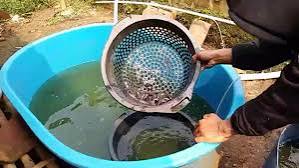When raising catfishes, no matter the feed you give them and no matter your kind of management, fish are not likely to grow at the same rate. Some will definitely grow faster than the other thus becoming bigger.
Catfishes of the family Clariidae, known as “Tarwada” in Hausa language, “Kumudu” in Kanuri and “Gbotongo” in Fulfulde languages, comprise the most commonly cultivated in Nigeria. The growth of Aquacultures rising in Nigeria and other countries at the expense of catfish now is largely being boosted.
Fishes, especially, catfish (Clarias gariepinus) are sources of food for human beings. It is very rich in proteins and vitamins, especially, vitamin A (Retinol). They are source of animal protein. Fishes such as those in the class Clariidae are highly, used and commercialized.
Every fish require energy for living, for growth maintenance, migration and reproduction, which is must to obtain food for its survival as well as adequate care.
Most of the time, bigger fishes do feed on the smaller one. So to prevent this, it is therefore necessary to sort your fishes. Sorting involve the process of separating the bigger fishes from the smaller ones.
Grading fish popularly referred to as sorting fish into groups of similar individual sizes is a common management practice in fish farming.
Fish sorting usually involves separating a mixed group of fish into different species, males and females, immature and mature fish, diseased and clean fish, etc. This is often done at the same time as grading and usually needs more skilled people.
Sorting catfishes will also increase market price of your fish because you will have the opportunity of selling smaller and bigger fishes separately at your own time and price.
Read Also: The Recommended Feeding Levels for Catfish at a Water temperature of 27-28°C
How Often to Sort your Catfishes
This depends on the number and how overcrowded they are. If they are properly stocked for instance: using the normal stocking density then you may not have to sort more than once a month.
However, I have had reason to sort once in every two weeks because the fish stocked in the pond were so many that the size disparity is easily noticed within two weeks.
So if you have stocked correctly, sorting once in a month will not be too small. However, there may be no need for sorting again after all of them have reached a size when none can feed on the other.
Read Also: How to Raise Catfish and Tilapia in the Same Fish Pond at the Same Time
The Best Time of the Day to do Sorting
Sorting is best done when the fish will not pass through too much stress. So early in the morning or late in the evening is recommended. However, whatever time is chosen, they should be starved for some hours prior to sorting so as to prevent crisis.
How Sorting Fish is Done

To sort, you have to drain the water from the pond and then divide the fish into groups based on their sizes. You will need some bows where you will put them during sorting.
After separating them based on their sizes, you then return them back into their different pond according to their matching sizes as this is the main reason behind you sorting fish.
You can choose to have 2, 3, or even 4 different size groups. This is another thing that should be considered before having a fish pond because a lot of water and some other empty ponds that will be used for sorting therefore prepare adequately for the water to use.
The sorting of fish into groups of the same species occurs only when different species of fish are farmed together. At harvest, either for stocking as juveniles or for marketing as food fish, the fish are first sorted by species before being graded, if necessary, by size.
Note: Fish may be sorted according to sex, for example when stocking fattening ponds for monosex culture of tilapia males or when stocking breeding ponds with a specific ratio of males to females.
Read Also: Advantages of Imported Catfish Feeds over Local Feeds

Reasons why you may need to grade / sort your Catfishes:
When harvesting juvenile fish, before stocking them in fattening ponds;
When separating faster- from slower-growing stock, for example male and female tilapias;
during the early life of predatory fish when the range of sizes becomes too large;
When selecting predatory fish for a suitable size to use for controlling fry populations;
When selecting fish of a suitable size for polyculture;
When harvesting a pond where fish of various ages and sizes are present;
During partial harvesting, to select the fish which have reached market size.
Advantages of Sorting/Grading Catfishes
Reducing fish losses through cannibalism;
Improving supplementary feeding efficiency through adequate food ration;
Increasing the accuracy of stock estimates for monitoring (see Section 16.0);
Reducing the proportion of small fish at harvest of fattening ponds;
Increasing production, for example by increasing the proportion of faster growing males in tilapia ponds.
Read Also: The Sizes of Feeds to give Catfish at a Particular Age
Grading or Sorting your Catfishes
Sorting fish by species is best done on a sorting table (see Image below). For resistant fish such as warm water fish in general, this method can also be used to grade fish by size.
Place removable sorting boards
A sorting table
Note: this illustration shows all removable boards in the closed position; they can be removed one by one to provide openings for sorting and grading fish from any or all corners or from the full-length lower end opening; place a container with clean, fresh water below each opening to collect the fish.
Read Also: How to Market your Matured Fishes for Profit
How to Use the Sorting Table for Catfishes
When using the sorting table, you should try to keep the fish in good condition. Proceed as follows.
(a) Set up the sorting table close to the harvesting site, it possible in the shade.
(b) Before starting, wet its surface well with clean water.
(e) Under each opening of the table, place a container with clean, fresh water, such as buckets, plastic basins or half metal drums which can be used to transport the fish.
(d) Use good handling nets with no rough or torn edges.
(e) Bring only small batches of fish to the table at a time. Put them in suitable temporary holding containers, with a regular change of clean water. This also helps to rinse them clean of mud, algae and plants.
(f) Transfer the fish gently on to the top of the sorting table.
(g) Have three or four qualified persons working around the table. The fish should be handled as little as possible and sorted quickly.
(h) Start sorting:
- First the large fish, if any, placing them directly in a dip net and into water;
- Then the fish which are in the smallest number, sliding them towards one of the corner openings into a container and water;
- Then the remaining group(s).
(i) After having sorted or graded this batch of fish, rinse the table well, with plenty of clean water.
(j) Place another batch of clean fish on the table and continue sorting or grading.
(k) Move the sorted fish as soon as possible to their recovery or destination areas.
At the end of the working day, clean the table well, dry it and store it in a protected place.
Note: The surface of the sorting table should always be perfectly smooth to avoid bruising the skin of fish. Regularly check your table surface and, it necessary, smooth it well with sandpaper and repaint it.
Read Also: Types of Hunting and their Negative Effects on Forest and Wildlife
Frequently Asked Questions
We will update this section soon.
